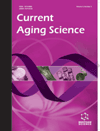- Home
- A-Z Publications
- Current Aging Science
- Previous Issues
- Volume 10, Issue 1, 2017
Current Aging Science - Volume 10, Issue 1, 2017
Volume 10, Issue 1, 2017
-
-
Aging and Ambiguous ROS. System Genetics Analysis
More LessAuthors: Vladislav S. Baranov and Elena V. BaranovaFamous Free Radical Theory (FRT) of aging, the 50th year anniversary of which is celebrated in 2015 postulates a crucial role of Reactive Oxygen Species (ROS) in aging. Still it is the most robust theory of aging as mitochondria ROS production (mtROSp) correlates well with four principal ‘‘rules” of aging being universal, endogenous, progressive, and deleterious. Vast number of experiments in different species prove muta Read More
-
-
-
Free Radical Timer of Aging: from Chemistry of Free Radicals to Systems Theory of Reliability
More LessThere are two generally known concepts in biology of aging. Accordingly to the first one, there is a program of aging. The alternative concept advocates that aging proceeds stochastically. In this area of research, free radical-theory of aging, which was put forward by Denham Harman in fifties of XXth century, has determined the most heuristic line. The goal of this review is to demonstrate how the aging program and the Read More
-
-
-
Role of Oxidative Stress in the Genesis of Atherosclerosis and Diabetes Mellitus: A Personal Look Back on 50 Years of Research
More LessAuthors: Vadim Z. Lankin and Alla K. TikhazeWe have provided an overview, based on the literature and our data. In accordance with the theory of D. Harman free radical processes cause damages that can accumulate and contribute to aging of the organism. Atherosclerosis and diabetes are developing for a long time so they are manifested predominantly in old age. We found an increase in the level of free radical peroxidation products and decrease in the activit Read More
-
-
-
Role of Reactive Oxygen Species in Premature Ageing of the Female Reproductive Function
More LessIndustrial xenobitics, as well as endogenous damaging factors, such as L-homocysteine, are a well-known source of reactive oxygen species that disrupt biological processes. Among many others, luteinizing hormone releasing hormone synthesis and secretion mediated by a variety of neurotransmitters, which are under control of the hypothalamus and pineal gland, may be put in peril by reactive oxygen species. Their Read More
-
-
-
Role of Ageing and Oxidative Stress in Regulation of Amyloid-Degrading Enzymes and Development of Neurodegeneration
More LessAuthors: Natalia N. Nalivaeva and Anthony J. TurnerThe accumulation of cerebral amyloid β-peptide (Aβ) is a key precipitating factor for neuronal cell death in Alzheimer’s Disease (AD). However, brain Aβ levels are modifiable since there is a balance between its formation from the Amyloid Precursor Protein (APP) and its removal by clearance mechanisms, which can be either through proteolysis or by protein binding and subsequent transport). Among the major enzy Read More
-
-
-
Cellular and Molecular Mechanisms of Action of Mitochondria-Targeted Antioxidants
More LessAuthors: Boris A. Feniouk and Vladimir P. SkulachevReactive oxygen species generated in mitochondria are an important factor contributing to mitochondrial and cellular dysfunction underlying many degenerative diseases, chronic pathologies and aging. The idea of delivering antioxidant molecules to mitochondria in vivo to treat these diseases and slow aging intensively developed in the last 20 years. Derivatives of quinones covalently conjugated to a lipophilic cation (e.g., MitoQ Read More
-
-
-
Physiological and Biochemical Mechanisms of Lifespan Regulation in Rats Kept Under Various Light Conditions
More LessBackground: The present study was aimed to identify how age-related changes in some physiological and biochemical systems are related to changes in the life span of rats with long-term pineal gland hypo- and hyperfunction induced by constant light and constant darkness, respectively. Methods: At the age of 25 days the rats were randomly divided into 3 groups: standard light/dark regimen (LD), constant light (LL) and c Read More
-
-
-
Fullerenes as Anti-Aging Antioxidants
More LessHere we review fullerenes biological effects focusing on their antioxidant and anti-ageing action. A scope of various poisonous and healing properties reported in literature for fullerene and its derivatives is analyzed. The review begins with the history of fullerenes discovery and their main properties. Then we focus on the longevity and antioxidant action, including the confrontation of available experimental data and t Read More
-
-
-
Chemical Modification of Ginsenoside on Cell Viability and Cytokine Secretion
More LessBackground: Rb1 is a ginsenoside steroid glycoside found exclusively in the plant Panax ginseng. In an earlier report, we showed that Rb1 increased cell proliferation and reduced VEGF (vascular endothelial growth factor) secretion by human retinal pigment epithelial (ARPE19) cells. Objective: In the present study, we hypothesized that chemical modification of Rb1 changes the level of VEGF secretion by ARPE19 cells. Method:Thre Read More
-
Volumes & issues
Most Read This Month
Article
content/journals/cas
Journal
10
5
false
en

Most Cited Most Cited RSS feed
-
-
Polyphenols and Aging
Authors: Brannon L. Queen and Trygve O. Tollefsbol
-
- More Less

